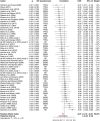Do eating behavior traits predict energy intake and body mass index? A systematic review and meta-analysis
- PMID: 36305739
- PMCID: PMC10078190
- DOI: 10.1111/obr.13515
Do eating behavior traits predict energy intake and body mass index? A systematic review and meta-analysis
Abstract
At present, it is unclear whether eating behavior traits (EBT) predict objectively measured short-term energy intake (EI) and longer-term energy balance as estimated by body mass index (BMI). This systematic review examined the impact of EBT on BMI and laboratory-based measures of EI in adults ( 18 years) in any BMI category, excluding self-report measures of EI. Articles were searched up until 28th October 2021 using MEDLINE, PsycINFO, EMBASE and Web of Science. Sixteen EBT were identified and the association between 10 EBT, EI and BMI were assessed using a random-effects meta-analysis. Other EBT outcomes were synthesized qualitatively. Risk of bias was assessed with the mixed methods appraisal tool. A total of 83 studies were included (mean BMI = 25.20 kg/m2 , mean age = 27 years and mean sample size = 70). Study quality was rated moderately high overall, with some concerns in sampling strategy and statistical analyses. Susceptibility to hunger (n = 6) and binge eating (n = 7) were the strongest predictors of EI. Disinhibition (n = 8) was the strongest predictor of BMI. Overall, EBT may be useful as phenotypic markers of susceptibility to overconsume or develop obesity (PROSPERO: CRD42021288694).
Keywords: eating behavior; energy intake; obesity.
© 2022 The Authors. Obesity Reviews published by John Wiley & Sons Ltd on behalf of World Obesity Federation.
Conflict of interest statement
Pr. James Stubbs consults for Slimming World UK through The University of Leeds. Slimming World was not involved in the analysis or interpretation of this review.
Figures







